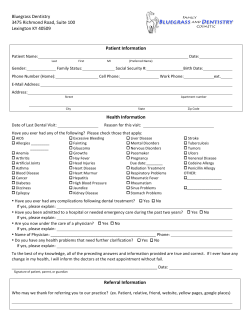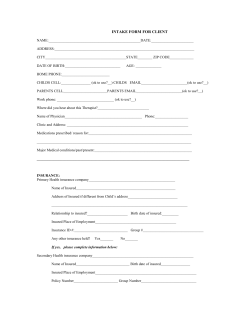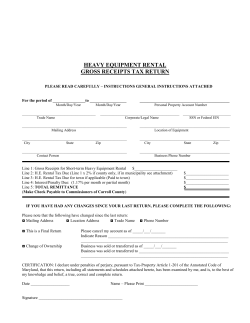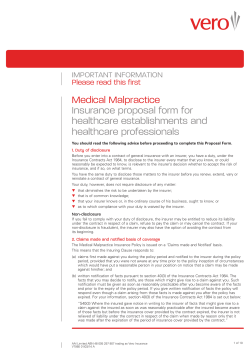
GROSS PROFIT WHAT IS GROSS PROFIT? Accountant – deducts direct costs
GROSS PROFIT WHAT IS GROSS PROFIT? Accountant – deducts direct costs Liability adjuster – deducts variable costs Property / BI adjuster – deducts uninsured working expenses defined in the policy COSTING IN GENERAL Every business needs to have some kind of costing system. - although many smaller businesses do not! Without one, management can have no idea of whether an individual product is making a profit or a loss. When dealing with claims we find wide variety of costing systems, however the basic principles are always there. Accountants categorise costs incurred by a business in two ways: Direct, or indirect Variable, or fixed Direct: Costs that are directly attributable to a unit of production. Indirect: Costs that cannot be attributed to an individual unit of production. Consider, as an example, the manufacture of motor vehicle sub assemblies which requires the raw materials which are machined by the workshop staff to form a manufactured part which is then assembled with a purchased part prior to incorporation into the vehicle. The machining process uses power and needs consumables such as lubricants. Workshop staff are paid for a 40-hour week irrespective of the number of parts produced. Direct costs are those which are directly incorporated in the unit of production. In this example, raw materials, workshop labour, purchased parts and power and consumables associated with machining are all direct costs. The cost of workshop supervision, power for light and heat and general machine repairs are indirect costs - they are not directly incorporated into a production unit. Example 1 Consider a Chinese takeaway restaurant and identify which of the following costs are direct or indirect: Costs Direct or Indirect Meat and vegetables Chef’s wages Packaging materials Gas and electricity Counter staff wages Telephone Rent and rates Direct Direct Direct Direct/Indirect Indirect Indirect Indirect As a separate exercise, costs can be categorised as either variable or fixed. We will see later that direct costs can be either variable or fixed. Variable: Cost varies directly with the number of units produced. If one more unit is manufactured, the cost increases proportionally. Fixed: Cost remains the same irrespective of the number of units produced, assuming the business continues. Going back to our example of the car manufacturer, variable costs are those which vary directly with the number of sub assemblies manufactured. In the example, raw materials, purchased parts, and power and consumables associated with machining are all variable costs - if the Insured manufactures one more sub-assembly, then the value of these costs will all increase. In this example, labour is not variable, it is fixed at least in the short term as the wages bill for the workshop will be the same whether 20 or 40 units are produced. We would, however, say that labour is semi-variable if overtime can be worked to meet production over 40 units, or variable in the long term if additional staff are recruited to meet demand. We would expect the cost of the workshop’s supervision, power for light and heating, and general routine repairs to be fixed in the short term. Example 2 Consider the Chinese takeaway restaurant again and identify which of the following costs are variable or fixed: Costs Variable or Fixed Meat and vegetables Chef’s wages Packaging materials Gas and electricity Counter staff wages Telephone Rent and rates Variable Fixed Variable Semi-variable Fixed Fixed Fixed You will notice in this example that in general, direct costs tend to be variable and indirect costs fixed, however this is not always the case and wages is often the exception which requires particular care. Exercise 1 Consider a manufacturer of chocolate bars. The factory produces 23 hours a day throughout the year. Production lines are stopped for an hour a day for cleaning and maintenance. The cleaning procedure is to meet with hygiene standards and must be completed irrespective of the amount of chocolate produced. Staff in the packing department are paid on a piecework basis. The plant is depreciated on a straight line basis over time and the contribution to group overhead was agreed at the beginning of the year. Identify which of the following costs are direct/indirect and variable/fixed. Costs Raw material ingredients Production wages Shift supervisor’s wages Cleaning/Maintenance wages Consumables/cleaning materials Packaging materials Packing department wages Factory rates Group overheads Depreciation Direct/Indirect Direct Direct Indirect Indirect Indirect Direct Direct Indirect Indirect Indirect Variable/Fixed Variable Fixed Fixed Fixed Fixed Variable Variable Fixed Fixed Fixed Standard Cost: To allow a manufacturing business to budget for and control costs during the year, many businesses operate a standard costing system. This sets quantities, materials and labour that will be required to produce a single unit and costs them at the rate incurred at a particular point in time. Labour and variable costs can readily be allocated to each unit of production but the allocation of fixed costs is more difficult. It is usual to estimate the number of parts that will be produced in the year and allocate the total expected annual costs over these units. Obviously, the allocation per unit will be incorrect if the number of units produced differs from the expected level. If an extra unit is manufactured, then the total rent paid for the year will not increase! The allocation of fixed costs can be very detailed. For example, a company may allocate the fixed costs for each department separately over only those units which pass through that department. While the Insured’s accountants will spend a great deal of time working out these costs, standard costs can vary from actual for the following reasons: Material costs: Production labour: Fixed costs: More or less material actually used than the standard quantity Cost price of materials changes More or less time actually taken to produce unit than the standard time allowed Hourly cost of labour different from standard Variation in actual costs from initial annual estimate Variation in the number of units produced Businesses will also often operate with a “standard selling price”. This in effect is a budget price and which it is unlikely that many customers will actually pay. The difference may affect turnover or be shown separately as discounts. At the end of the month or possibly quarter, the Management Accountants will produce what is known as a variance analysis which compare the actual costs incurred against the standard cost. If costs incurred are greater than the standard then the variance is described as adverse, whilst if the cost is less than standard then the variance is described as favourable. When we are dealing with a manufacturing business and discussing their costing system, we must always check whether it is a standard costing system and, if it is, ask to review the variance analysis. If variances are substantial, then we will need to adjust the standard cost to allow for this when making a payment. Overlap between property damage and gross profit Cost structure for damaged items: Selling price Materials Power Gross profit Wages Overheads Net profit Rate of gross profit 100 (20) (5) 75 25 20 30 75 x 100% = 100 75% If the sale is lost then the Business Interruption loss is £100 (selling price) x 75% (rate of gross profit) = £75. What would the property damage loss adjuster pay in respect of stock? We would be happy to pay the materials and power elements as the stock loss as these are the direct variable costs. Together materials and power total £25. It cannot be right that the claimant receives more than the selling price in total, so we are justified in not paying the wages element. Rate of Gross Profit We have now calculated the reduction in turnover and to this we need to apply a suitable rate of gross profit. Why? Retailers - lost sales will result in a saving in goods purchased. Manufacturers - lost sales results in a saving in materials which would have been used in the manufacturing process. In broad terms, gross profit for our purposes can be defined as sales less direct variable costs as adjusted for movements in stock. We need to consider which costs we are going to deduct. Policy definition of Gross Profit The amount by which the sum of the amount of the Turnover and the amounts of the closing stock and work in progress Shall exceed The sum of the amounts of the opening stock and work in progress and the amount of the Uninsured Working Expenses. Or numerically: Turnover Opening stock Uninsured Working Expenses Less Closing stock x x x (x) Gross Profit (x) x This is best illustrated by way of example. Consider a manufacturing company. The accountants view - if you were to ask the managing director what the company’s rate of gross profit was then he may well tell you 32% as follows: £ £ Sales 50,000 Opening Stock 5,000 Purchases 20,000 Wages 7,000 Maintenance 6,000 38,000 Closing Stock (4,000) (34,000) Gross Profit 16,000 Rate of gross profit = 16,000 x 100% = 32% 50,000 The BI loss adjusters view - we establish that uninsured working expenses are purchases only and calculate the rate of gross profit to be 58% as follows: £ Sales Opening stock Purchases Closing stock Gross Profit Rate of gross profit = 29,000 x 100% = 58% 50,000 £ 50,000 5,000 20,000 25,000 (4,000) 21,000 29,000 By calculating the rate of gross profit in this way, we are allowing that in the event that sales are lost wages continue to be paid. This is realistic in that unless staff are paid on a piecework basis, wages will continue to be paid. Uninsured Working Expenses These should be defined in the policy schedule – but they often aren’t. If clarification cannot be obtained then the business interruption loss adjuster will have to make a working assumption in order to settle the loss. We are provided with the following profit & loss account: £ Turnover Opening stock Raw materials Packaging materials Production wages Salaries Bad debts Consumables Depreciation Closing stock £ 1,500,000 50,000 500,000 50,000 300,000 200,000 10,000 40,000 80,000 230,000 (55,000) (1,175,000) 325,000 A reasonable assumption might be: £ Turnover Opening stock Raw materials Packaging materials Bad debts Consumables Closing stock £ 1,500,000 50,000 500,000 50,000 10,000 40,000 650,000 (55,000) (595,000) 905,000 Rate of gross profit = 905,000 x 100% = 60% 1,500,000 What would we assume uninsured working expenses to be for the following businesses and what would we expect the insured rate of gross profit to be? Hotel Rooms Bar and restaurant Garage Sale of new cars Sale of used cars Servicing Paint shop Fuel Clothing retailer Designer wear Department store Budget chain ADEQUACY OF BUSINESS INTERRUPTION COVER INTRODUCTION As with material damage policies Insurers need to collect premium linked to the size of risk they are taking on. There are two common types of Business Interruption Policy:* * Sum Insured Basis Estimated Gross Profit or Declaration Linked Basis Sum Insured Basis The essence of this cover is that if the gross profit which would have been earned in the Maximum Indemnity Period had the incident not occurred is more than the Sum Insured then any amount payable under the policy will be proportionately reduced. This is a similar calculation to “Average” as it appears in material damage policies. Estimated Gross Profit The Insured makes a declaration at the end of each financial year disclosing the insured gross profit earned by the business that year. The Insured’s estimate of insured gross profit that will be earned in the financial year most concurrent with the insurance period is disclosed to Insurers and is known as Estimated Gross Profit. Cover is provided with a Policy Limit of 133.3% (or occasionally 150%) of Estimated Gross Profit. If Estimated Gross Profit proves to be an under or over estimate then the Insured will be required to pay additional premium or will receive a rebate. In this way, provided that the declarations are correctly made, there is little possibility of the limit being breached. SUM INSURED BASIS The standard Business Interruption Policy on a Sum Insured Basis states that: “if the Sum Insured by this item be less than the sum produced by applying the Rate of Gross Profit to the Annual Turnover (or to a proportionately increased multiple thereof where the Maximum Indemnity Period exceeds 12 months) the amount payable shall be proportionately reduced”. So that we can check the adequacy of the Sum Insured we need to estimate the Gross Profit which would have been earned in the Maximum Indemnity Period but for the incident. This is known as the Insurable Amount (although it is not referred to in the standard policy). We need to take account of the trend in the business. The trend used will probably be the same as that used to quantify the loss however a different trend could perhaps apply to later periods. The standard policy compares the Sum Insured with Annual Turnover multiplied by Rate of Gross Profit as adjusted for the length of the Maximum Indemnity Period. For a Maximum Indemnity Period of less than 12 months, for example a machinery breakdown policy with a 6 months Maximum Indemnity Period, the Insurable Amount is the gross profit that would have been earned in the 12 months from the date of the loss. How do we calculate the Insurable Amount for a 24 month Maximum Indemnity Period? Correct method: Turnover in last 12 months £ 500,000 Add trend - 10% £ 550,000 Rate of Gross Profit 40% Gross Profit for 12 months £ 220,000 Insurable Amount for 24 months (X2) £ 440,000 Incorrect method: Turnover in last 12 months £ 500,000 Turnover in first 12 months (£500,000 + 10% trend) 550,000 Turnover in second 12 months (£550,000 + 10% trend) £ 605,000 Turnover for 24 months £1,155.000 Rate of Gross Profit Insurable Amount for 24 months 40% £ 462,000 It could be said that as the trend is not applied in the second year this calculation allows the Insured an element of under insurance. The most accurate way to calculate the Insurable Amount is to calculate the actual Gross Profit earned in the Maximum Indemnity Period and to add the loss of Gross Profit suffered. How do we apply proportionate reduction? Example: Sum Insured £200,000 Insurable Amount £250,000 Business Interruption Loss £100,000 Amount Payable = Sum Insured Insurable Amount = £200,000 £250,000 = £ 80,000 X Loss X £100,000 Proportionate Reduction does not apply to any Accountants Fees paid. How can Under Insurance Arise? Obviously Under Insurance arises when the Sum Insured is too low! This can arise in the following circumstances: • The Insured (or his Broker or Accountant) set the Sum Insured based upon the last available set of audited accounts. We must remember that the fire could occur on the last day of the Insurance year. If the Maximum Indemnity Period is 12 months then the Insured must “predict” the trend in the business for a 2 year period. • The Sum Insured has been calculated on the rate of Gross Profit calculated in the audited account and not the Rate of Gross Profit as defined in the policy which will normally be somewhat higher. • Common Misconceptions a) The Sum Insured is perceived to be a limit. The Insured sets the Sum Insured at say £100,000 in the belief that this is the maximum loss he could suffer even though the Insurable Amount should be say £500,000. b) The Insured is adamant that whatever happens the business will only be interrupted for say 3 months and sets the Sum Insured on this basis even though the policy provides a Maximum Indemnity Period of 12 months. ESTIMATED GROSS PROFIT The standard Declaration Linked policy provides cover for loss of Gross Profit to a limit of £133.3% of Estimated Gross Profit. Estimated Gross Profit is defined as: “the amount declared by the Insured to the Insurer as representing not less than the Gross Profit which is anticipated will be earned by the business during the financial year most nearly concurrent with the period of Insurance (or a proportionately increase multiple thereof where the Maximum Indemnity Period exceeds 12 months). In theory provided that Estimated Gross Profit is correctly calculated there cannot be under insurance. The Insured will only suffer from under insurance in circumstances where the Business Interruption loss exceeds the policy limit (ie, 133.3% of Estimated Gross Profit). How can Under Insurance Arise? Under Insurance will arise when the Estimated Gross Profit figure is too low. This is most likely to occur when the annual declarations and calculation of Estimated Gross Profit have been based upon the Rate of Gross Profit shown in the audited accounts and not the Rate of Gross Profit as defined in the policy which is usually higher. OTHER POLICY TYPES Many package policies for small shops, hotels etc. provide standard Business Interruption cover. For example a Policy Limit of £600,000 with a Maximum Indemnity Period of 24 months. It is likely that only the smaller business will be covered by such a policy and that the limit is likely to be adequate. BUSINESS INTERRUPTION RESERVES WHY ARE RESERVES IMPORTANT? Reserves are important to both Insurers and the Adjuster: Insurers 1. To allow quarterly returns of projected liabilities to be made to the DTI 2. To ensure that the correct level of funds is transferred from long term high return investments to more accessible accounts to meet claim payments Adjusters 1. To allow consideration of appropriate loss mitigation steps. 2. To ensure through our Large Loss Procedures that claims are dealt with by suitably experienced staff. HOW DO WE GET THE BUSINESS INTERRUPTION RESERVE RIGHT? Business Interruption reserves can be difficult to estimate accurately. While on occasions it will be necessary to substantially increase a reserve due to factors that are beyond anyone’s control and turn out to be worse than initially anticipated, this should not be the norm. Provided that the adjuster asks the right questions at the outset and perseveres until he has received sensible answers from the Insured there should generally be no reason why the initial reserve should not be a reasonable estimate of the actual loss. It is imperative that we: 1. Understand the Insured’s business 2. Understand the potential effect of the loss on the business 3. CALCULATE the probable extent of the loss Understanding the Insured’s business We must have a general understanding of the Insured’s business to deal with the Material Damage loss but we cannot begin to deal with the resultant Business Interruption Loss unless we have a detailed understanding of how the business operates For example: 1. What does the Insured do? Who are the main customers? Large contracts or many small orders? Competitors? Order turnaround period? Seasonality? 2. Financial Data Turnover - by department or machine? Insured rate of gross profit - by department or machine? 3. Use of Computers in the Business Wages and accounts? Order processing? Stock control? Production planning? Control of production plant? 4. Software used on each Computer Standard package? Dongle protected? Bespoke program? Back ups? 5. Data Back Up Regime Effect of the Loss on the business The effect of the loss of identical equipment will be very different from business to business. Every business depends on its assets to do different things. We must therefore consider the effect of the loss on the Insured’s business specifically: 1. Precisely what has been lost? Computer hardware and other equipment - detailed specification? Software? Data - may include work in progress? 2. How quickly can the lost items be replaced - realistically? Availability? Policy liability / Interim payments? 3. Mitigation steps Hire equipment? Sub contracting? Temporary premises? 4. Might business be lost? Work in progress lost? Order lead times? Will customers go elsewhere permanently? CALCULATE the probable extent of the loss It is not acceptable to simply assume that the Business Interruption aspect will be limited to Increase in Cost of Working by way of overtime or subcontracting and to ‘guess’ a reserve of £5,000. If you have asked the right questions you can by making some detailed assumptions calculate the probable extent of the loss. If we are dealing with a substantial loss it is good practice to explain in the Business Interruption Preliminary Report the assumptions used in arriving at the reserve. We need to consider: 1. Period of interruption - include any ongoing disruption after repair / replacement 2. Reduction in turnover 3. Rate of Gross Profit - as defined in the Policy 4. Increase in Cost of Working 5. Savings - be cautious 6. Adequacy of Policy cover COMMON PITFALLS The common pitfalls to avoid are: 1. Not appreciating how the asset affected by the incident is used in the business 2. Accepting the Insured’s optimistic view on day one - equipment cannot always be replaced tomorrow with no disruption to the business 3. Ignoring the likely long term effects on the business 4. Calculating the reserve using the Rate of Gross Profit shown in the accounts rather than that defined in the Policy which could be substantially higher CONCLUSION Setting a Business Interruption reserve can be difficult but if relevant information is obtained on day one we should generally be able to be reasonably accurate. If, immediately after the loss, there are major uncertainties which will drastically affect the reserve it is good practice to set the initial reserve based upon a ‘reasonable worse case scenario’. The possible permanent loss of a major customer is a good example. We should reserve based upon the loss of the customer explaining our assumptions and as soon as the picture is clear the reserve should be reviewed and reduced if appropriate. Unfortunately however there will be some losses where the probable effect of the incident on the business cannot be ascertained on day one and the Business Interruption reserve may have to be increased substantially at a later stage. There should always be a specific reason for this. Heather Parkinson October 2007
© Copyright 2025










